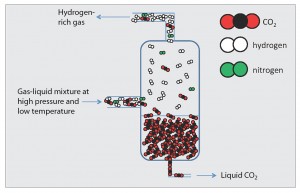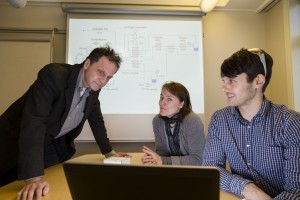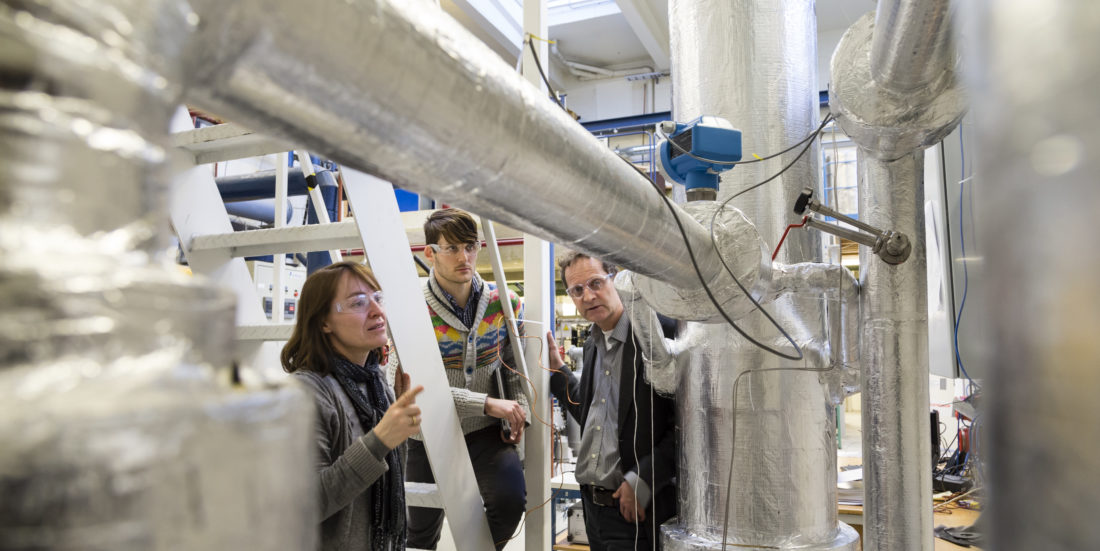Cold short-cut to CO2 storage
Could refrigeration technology – against all the odds – kick-start CO2 storage in the North Sea?
All over the world, scientists are on the hunt for solutions that will allow CO2 to be captured from large power stations and industrial plants. Many of the methods in use today employ chemicals or advanced materials to extract CO2 from flue-gases. But now, a chilly alternative is showing signs of heating up.
When CO2-rich gases are compressed and refrigerated, the carbon dioxide turns into a liquid – like steam on a cold bathroom mirror – and can be drawn off. Calculations performed by SINTEF, the largest independent research organisation in Scandinavia, suggest that in many cases, this method is cheaper and less energy-intensive than competing capture methods, in spite of predictions that the opposite would turn out to be true. This is good news for everyone who hopes that Europe will soon start to implement carbon capture and storage (CCS).
“CO2 captured in liquid form can be loaded straight aboard a vessel and be transported to offshore storage sites before pipelines have been laid. If our findings open up the possibility of cold CO2 capture, they could help to bring forward the introduction of CO2 storage beneath the North Sea,” says SINTEF research scientist Kristin Jordal.

CO2 capture based on refrigeration has a number of potential applications. The figure shows how CO2 can be removed from gasified coal – i.e. coal which has been transformed into gas. Once CO2 is condensed, the remaining fuel gas can be burnt in a gas turbine power plant. Since the fuel is virtually free from CO2, there will be next to no CO2 in the power’s station’s flue-gases either. Illustration: SINTEF Energy Research.
Sceptical
The scientists estimate that cold technology could cut the energy consumption and cost of CO2 capture by as much as 30 per cent in one of the “green” coal-fired power stations that the world is currently sniffing at.
The SINTEF scientists believe that the method will also be suitable for capturing CO2 when hydrogen is separated out of natural gas, as well as in cement, iron and steel production (see Fact-box).
“We started to do these calculations out of sheer curiosity in the course of the European Union project DECARBit. Many people doubted whether refrigeration technology would save energy and costs in this context, and the project therefore scarcely passed through the needle’s eye in Brussels. But once we were given the green light, we were able to show that there are a number of important potential improvements to be made in the process. That said, cold CO2 capture turned out to be one of the most promising technologies,” says Jordal, although she emphasises that more research is needed before the answers can be regarded as final.
She and her colleagues find the results particularly satisfying in view of the low expectations that many commentators had ahead of the project.
Several potential applications
- As a point of departure, SINTEF restricted its analyses of cold CO2 capture to a single application: "green" electricity generation based on coal gasification. This involves turning coal into an energy-rich gas from which CO2 must be removed before it is sent to a power station for combustion.
- However, the scientists who performed the calculations also envisage other potential applications. Among other possibilities, they believe that a combination of cold CO2 capture and membrane technology would be suitable for the production of highly purified hydrogen from natural gas or coal.
- In combination with membranes that raise the CO2 concentration in exhaust gases, the technology might also be suitable as a means of capturing CO2 from flue-gases in coal-fired power stations, cement factories and iron- and steelworks, say the SINTEF scientists.
Stumbled on discovery
Sometimes it can be a good idea to test unlikely hypotheses. When the scientists first realised that the cold technology was promising, they almost missed the next, and perhaps most important, point.
As Jordal points out: “None of us who are working on CO2 capture thought of shipping when we started, but when my colleague Simon Roussanaly who works on CO2 transport saw the process, he immediately pointed out that low-temperature CO2 capture would give us liquid CO2, at just the temperature and pressure needed to load it on board a ship. It was almost too good to be true!”.
First ships – then pipelines
Until now, it has usually been regarded as most cost-effective and energy-efficient to send gaseous CO2 to its storage site by pipeline. This is because most of today’s CO2 capture technologies separate it out as a gas.

Core participants in the “Cold CO2 Capture” project discuss their results. From the left; chief scientist Petter Nekså, research scientist Kristin Jordal and David Berstad, MSc, all of SINTEF Energy Research. Photo: SINTEF/Thor Nielsen
“However, it can take a long time to get all the decisions regarding CO2 transport pipelines in place. Will individual actors need to invest in small pipelines, or wait until several of them can agree to build a large one? By capturing CO2 in the state of a chilled liquid, we could start shipping it out while discussions about pipelines are still on-going,” says Jordal.
She points out that it would be quite possible to design cold capture processes in such a way that they could relatively easily be modified in the future; from delivering liquid CO2 for shipping, to supplying it as a gas at the high pressure needed to transport it by pipeline.
“This could enable us to gradually develop CCS in the North Sea,” says Kristin Jordal.
Cold CO2 capture
- The process is carried out using compressors, heat-exchangers and turbines, as well as tanks in which the gas and liquid are separated – all well-known process industry components.
- It operates according to a simple principle: when mixtures of gases obtained from gasifying coal are chilled, heavy molecules such as CO2 are the first to condense into a liquid. As long as the temperature is not lowered any further, the other molecules (such as hydrogen) remain in gas form.
- SINTEF's work on "Cold CO2 capture" started as part of the EU's "DECARBit" project, and has subsequently been supported by Gassnova SF, a public enterprise which is responsible for the Norwegian state’s interests in CO2 capture and storage.

